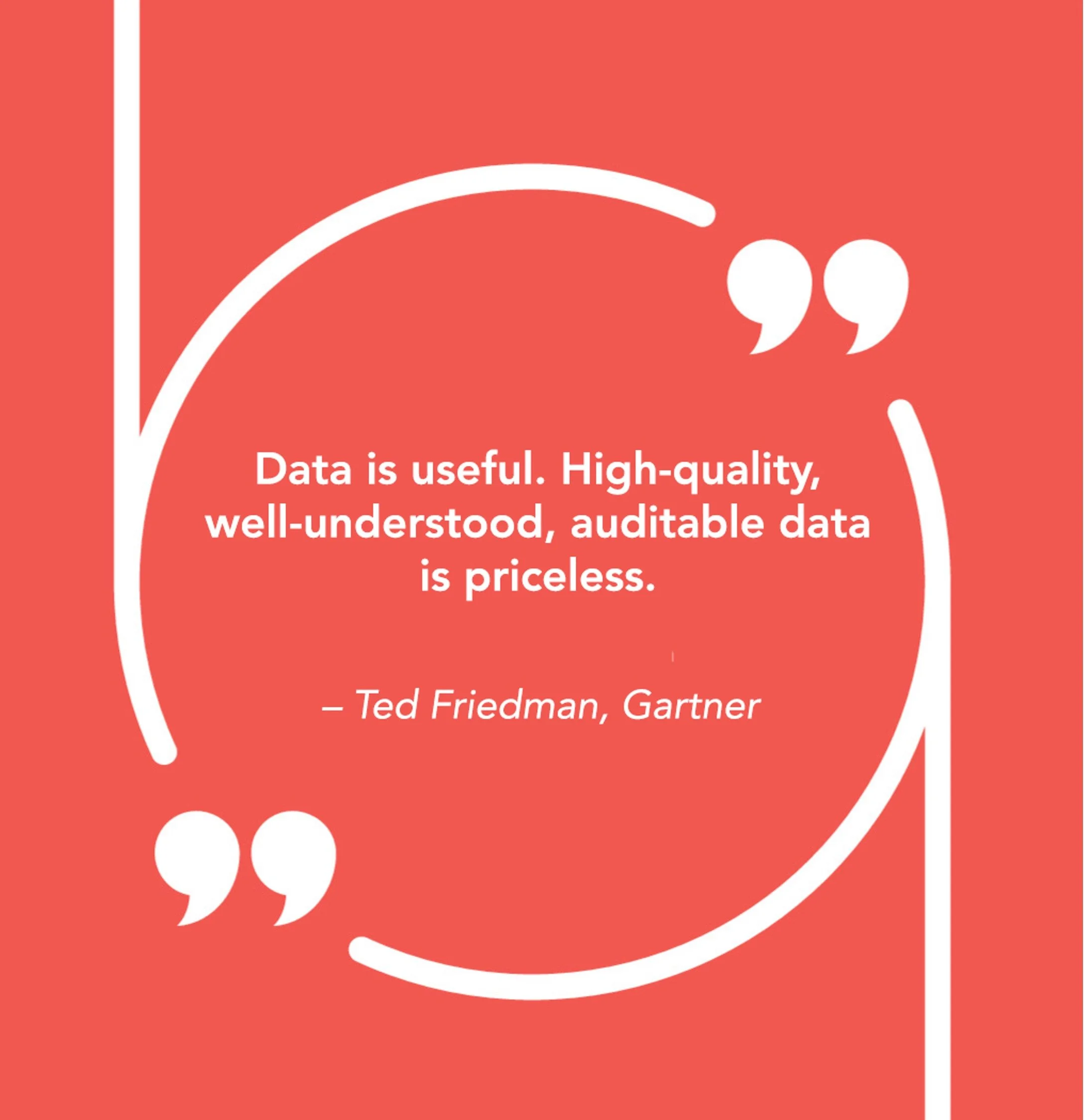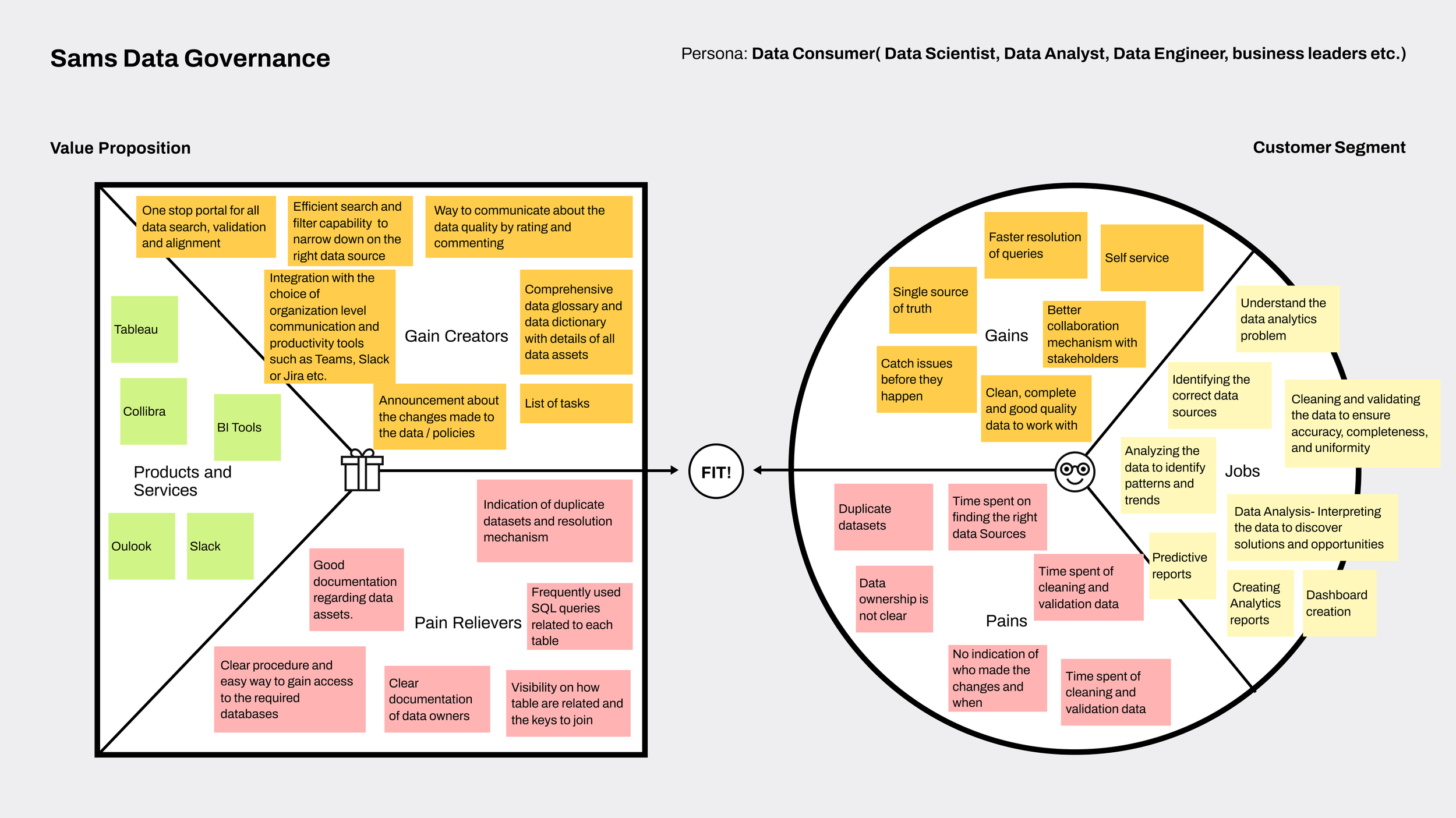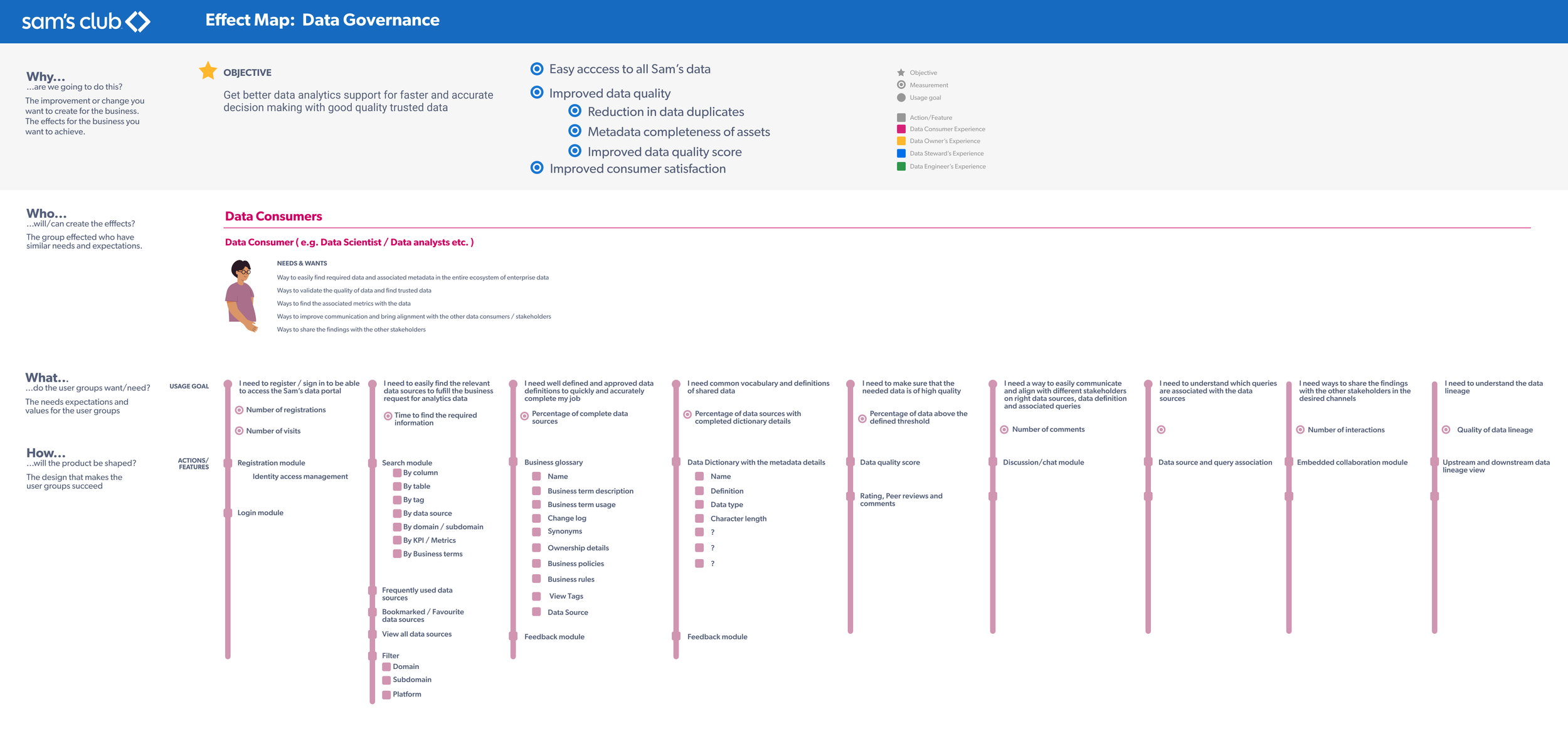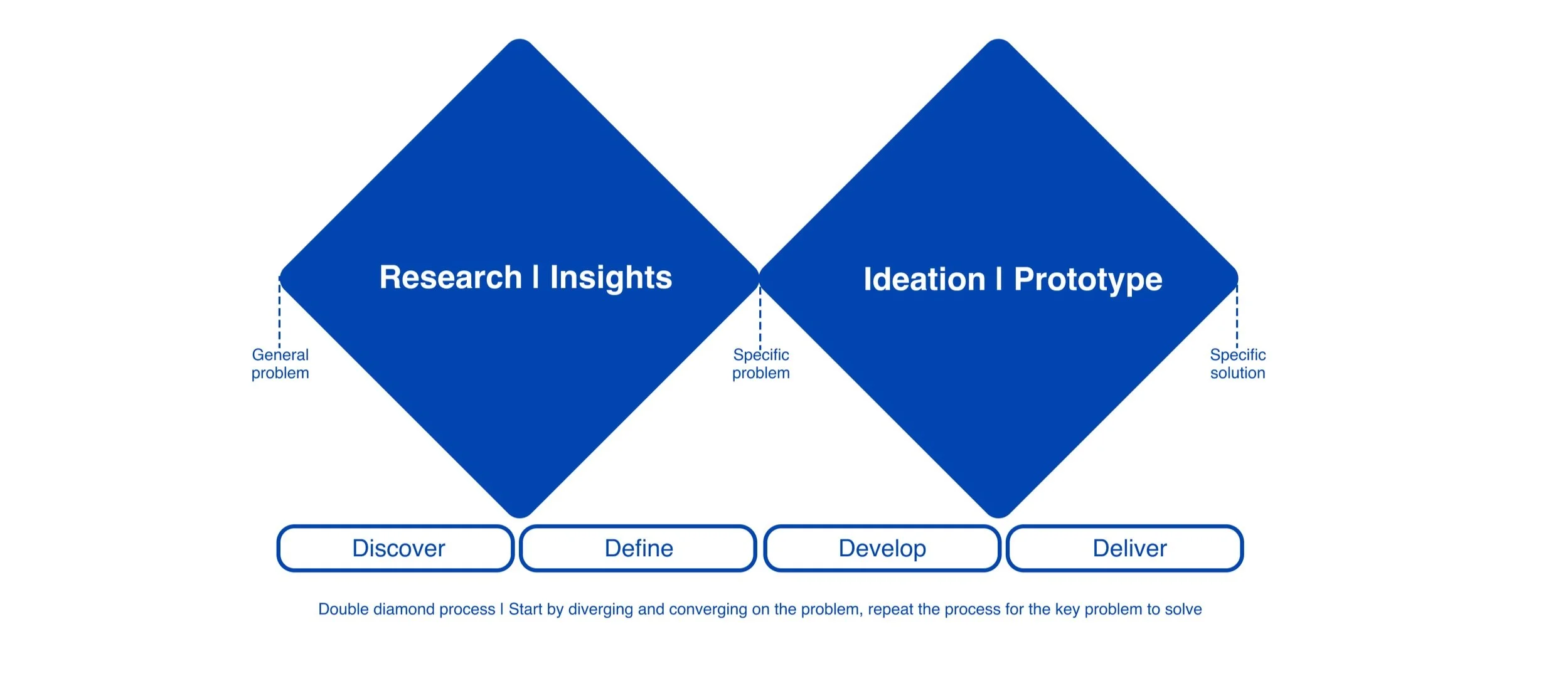overview - Data governance
Business identified the need to have a more robust data governance process within the organization. Few stakeholders from business, product and marketing were brought together to bring this vision to life.
Stakeholders from different teams had different views about -
What are they solving for?
Who are they solving for?
What business outcomes are expected and how to measure success?
Alignment among different stakeholders was missing regarding goals and objectives. At this stage of the project, I was brought in to help bring alignment, clarity and set the user experience startegy.
problem statement
Data consumers struggle to find the right and good quality data due to distributed, disconnected, and ungoverned nature of the current systems. This leads to a lack of trust and confidence in data across the organization. This also hampers their ability to make strategic decisions quickly and efficiently.
Objective
How might we make data-led decision-making faster, and better to elevate everyone’s confidence in data across the organization?
My Role
Collaborate: I worked with different stakeholders from business, product, and engineering to bring clarity and alignment among the stakeholders.
Discover: With the initial hypothesis around why, who, what, and how, I started surveys and focus group discussions to define the user personas, and understand their pain points and motivations.
Define north star vision: With the insights gathered from potential users and subject matter experts, I created an effect map that helped everyone to visualize the knowns, unknowns, and the north star for this project.
Define ways of working: Establish ways of working with different teams.
Project scope, estimates, and resource allocation: Once the whole team was aligned on the goals, objectives, and high-level features, I worked on the project plan, estimates, and resource requirements.
Work allocation and reviews: Working with different stakeholders and the designer allocate and review the work to ensure timely completion and desired quality.
Why Data Governance
To avoid inconsistent data silos in different departments and business units.
To agree on common data definitions for a shared understanding of data.
To improve data quality.
To increase analytics accuracy and give decision-makers reliable information.
To implement and enforce policies that help prevent data errors and misuse.
To help ensure compliance with data privacy laws and other regulations.
Research
Reached out to the organization’s data community members to understand the user profiles, roles, responsibilities, and challenges.
A Continuous Discovery and Continuous Integration Process is established to make design decisions based on user feedback.
I started this discovery myself initially and later onboarded a researcher.
In the first phase, we started reaching out to the below personas –
Data Stewards
Data Scientists
Data Analysts
Data Engineers
Data Owners
Business Leadership
Methods: Online Surveys, Focus group discussions, co-creation workshops, Industry benchmarking
Key User Groups
I defined two key user groups based on this initial study.
Data Consumers
Anyone in the organisation who is consuming data to help businesses make data-informed decisions and achieve desired business goals.
Sample Persona
Data steward
Floyd Miles, 42 Yrs old, Male
Floyd is appointed as a data steward for Finance domain. He is a SME and has a thorough understanding of the financial domain data.
He was not hired for the role and stretches his time to accommodate data governance responsibilities. His job as a data steward is to ensure that the enterprise data is of high quality and can be used effectively. The current processes and tools are not helping him in doing this job quickly and effectively.
Data Enablers
Enablers are the users who enable consumers by managing clean, complete and governed high-quality data.
RESPONSIBILITIES
Create and manage metadata for the data set they are responsible for. (Data Catalogue/ Data Dictionary / Business Glossary)
Ensure data quality is maintained across the domains and subdomains.
Bring context to data so that it is optimized for consumption.
Ensure the security of data while collecting and sharing data, striking a balance between transparency and privacy.
Enforce operational data governance activities like setting up rules, policies, standards, definitions, and processes.
Creation and documentation of data roles and standards and collecting feedback.
Monitor usage of data and help identify ways to use data to attain organizational objectives.
NEEDS / WANTSMake clean and complete data available for data consumers.
Make sure that the right stakeholders are documented and engaged.
Make sure that the right data definitions are present and up-to-date.
Remove duplicate business terms which lead to confusion, waste time, and pose risks to business decisions.
Better ways to collaborate.
Monitor the lifecycle of data.
PAIN POINTSUnclear roles and responsibilities.
Maintaining incomplete/missing/duplicate asset information.
Ensuring data accuracy and access to clean data.
Change management.
Manual processes make data governance responsibilities time-consuming.
Painpoints
THEMES
Finding Data
Unclear Roles and Responsibilities
Incomplete / Missing Asset Information
Duplicate Data
Data Quality
Time spent on alignment
Change Management for data, people and processes
Data Lineage
The INSIGHTS - Value proposition
I consolidated my research findings and insights gathered from business and product into a value proposition map.
As per the customer segment their jobs to be done, pains and gains were mapped on one side, and on the other side, we added the gain creators and pain relievers. This helped us to define the “Fit”. We arrived at the value proposition which was a “Data club” that will support data literacy and governance.
Effect Map
I created the effect Map define the business objectives, document the users who are getting effected or who can create an impact, user needs, wants and how do we envision to support those needs and wants. It helped in presenting a collective vision to bring alignment with the business, product, engineering and other UX stakeholders.
StoryBoard


UX vision Goals
If we do a great job at building Sams Data Club
we will improve lives of all the data citizens ( data scientist, data analysts, data engineer etc.)
by making it easier for them to discover trust worthy data sources and the associated metadata details
so that we can reduce data consumers time to find the right data assets from weeks to few hours and also elevate their level of trust on the available data
so that they can spend more time in generating analytics and predictions for business to acheive business goals.
If we do a great job at building Stewardship Module
we will improve lives of all the data stewards ( business / technical data stewards, Lead data stewards, data owners etc. )
by making it easier for them to manage their domain and subdomain data sources and the associated metadata details
so that data consumers get access to clean and complete data to do their job
so that business can make decisions faster and reduce risks.
If we do a great job at building capabilities for Data Governance Office
we will improve lives of all the data governance office staff
by making change management easier for them
so that they can manage vision and strategy for the organizations data with ease
Ways of working
Design Methodology
UX Activities, Timelines and Deliverables
Solutions
Click on next and previous arrow to view the designs for different usecases.
Key features of the project designed and developed until now -
Easy guided onboarding - Guided onboarding for the first time users to help them navigate the new system. Based on the user profile the users are guided either to the registration screen or the home page. Users who are visiting only to browse the system don’t need to register.
Home page - Sams Data Club homepage welcomes the users and highlights the vision and mission, recently viewed data, key tasks etc.
Robust search capability - With global and contextual search options as well as scoped search funtionality users can find the required data very quickly
Data management - Enable users to create, view, update and delete the data
User and role management - Assign roles and manage it for clean data
Connected view for technical and business data - To make sense of data it is important that users get the connected view of reports, metrics, connected tables and columns
Capability for stewards to work together on assets with issues and resolve them - Enable capability for multiple users to work on a single asset
Domain specific data views - Support for finance domain to complete their goals for annual operating plans and similarly for other domains.
Raise an issue / concern - Users can easily raise their issues or concerns or provide feedback
Certification of the assets - Provide certification details to the data consumers for increased confidence. Enable enablers to be able to certify all the data assets
( More design reference artifacts can be provided on request)
Objectives & key results
100% of data stewards registered and actively using the portal
100% of the critical data is certified
1. Implement effective Data Governance
2. Improve customer satisfaction
Increased NPS score from -65 to 80
Reduced time to find data from weeks to minutes
Reduced time to validate data information from weeks to 1 day
Preferred one source for data information by data citizens and enablers
95% completion of the information
95% confidence level in data
3. Create an uber catalog for all data needs
Auto classification, notification and update on new jobs
4. Identify, document and manage data universe
Wins
Enterprise data governance team adopting the work done for a single business group
Shifting the team’s focus from outputs to outcomes
Bringing Alignment by engaging with stakeholders from Design, Business, Product, and Engineering
Building empathy through storytelling
Evangelizing UX
Prioritization and roadmap planning
Effort estimation and resource planning
Onboarding research early in the project and forming a user advisory committee











